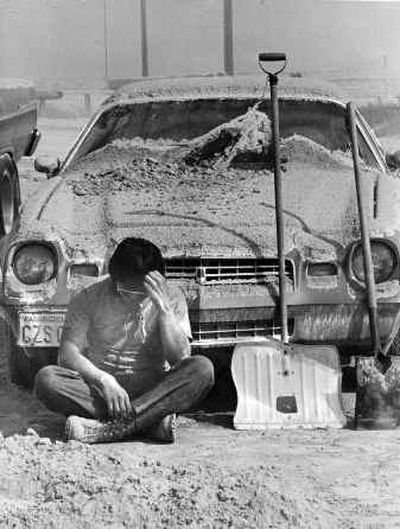Rumblings trigger memories of ash-filled days of 1980

By all accounts, it must have seemed like the end of the world.
Scalloped black clouds moved in to block sun rays and radio signals.
Deeply imprinted by secondhand accounts and photos, I’ve accepted that the Mount St. Helens explosion was the wildest thing most people in Spokane had ever seen.
Pitch black at 3 p.m.! Holy cow!
While that May 18, 1980, day feels very real to me, I have no real firsthand connection to the event. I was a sixth-grader in southern Idaho. No ash fell on my home. IMAX film deserves most of the credit for my appreciation of what happened that day. I did pick up a ceramic St. Helens ash pot once in the ‘80s, but that’s it.
On Wednesday when I heard scientists were issuing a volcano warning, I nearly cheered.
“Yeah, maybe it’ll blow!”
On Thursday, when a 70 percent chance of a minor eruption was announced, I wasn’t quite so excited. This was getting a little too real.
I wondered what it was like back in the pre-eruption phase in 1980. There were daily reports of a growing bulge that squirmed around the mountain.
A 1982 U.S. Department of Interior report gave a blow-by-blow retelling.
Two years before Mount St. Helens blew in 1980, a U.S. geological survey predicted some sort of explosive activity by the year 2000.
On March 20, 1980, an earthquake hit 4.2 on the Richter scale. Hundreds of following quakes shook the mountain. The first small eruption that started spewing ash came a week later. More eruptions followed. By May, the earthquakes grew stronger, 5.0 on the Richter scale. A bulge on the north flank of the volcano continued to grow six feet per day.
One minute before the eruption, the situation appeared as it had for the preceding month. No hint or clear warning came. There hadn’t been an eruption in four days and the bulge still swelled.
And, boom.
The skies looked like a giant inkwell spill over Spokane, said one columnist back then. Then came the ash.
I’ve seen the photos of people wearing masks, the videos shots of dusty streets and horses shaking off ash, which all look ancient now.
That was a different era. That was when there was still such a thing as newsboys, dedicated youth who delivered the newspaper.
Ken Johnson, a Spokesman-Review district manager in circulation, was a carrier then. He was 18, a senior at Rogers High School. He was a coach of a soccer team and was gathered with the team at Pine River Park.
“We got word Mount St. Helen blew,” Johnson said. “Of course, no one cared.”
Then little gray ash flakes started appearing on their clothes.
“We were all like, ‘Hey, look at this!’ “
News of an approaching ash cloud sent them all home. Officials wanted everyone to stay inside, but the next day was a Sunday, the biggest newspaper of the week.
Some carriers bailed on their duties. Johnson showed up. Only emergency vehicles were allowed on the roads. But also out on the streets were hundreds of carriers, some of them in masks.
It was quiet, like it always is on a Sunday morning.
“We felt like it was fun to be out,” Johnson said. He remembered how they were among the few bodies on the streets. “I guess you felt like a rebel. As a paper carrier, you’re told to get the route done.”
No one knew how the ash could affect your health or even your car engine.
“The first day was roughest because a lot of carriers didn’t want to go out,” said Bob Marshall, a Spokesman-Review circulation manager.
“You told them not to worry,” Marshall said. “Most of the parents took their kids around.”
This was before the Internet and 24-hour cable news networks.
News-hungry people snatched up piles of papers left around town for carriers.
Should Mount St. Helens go up in smoke this time, there’ll be live feeds zapped around the globe.
Video’s nice, but I’ll be looking for my paper outside my door. I’m biased that way.